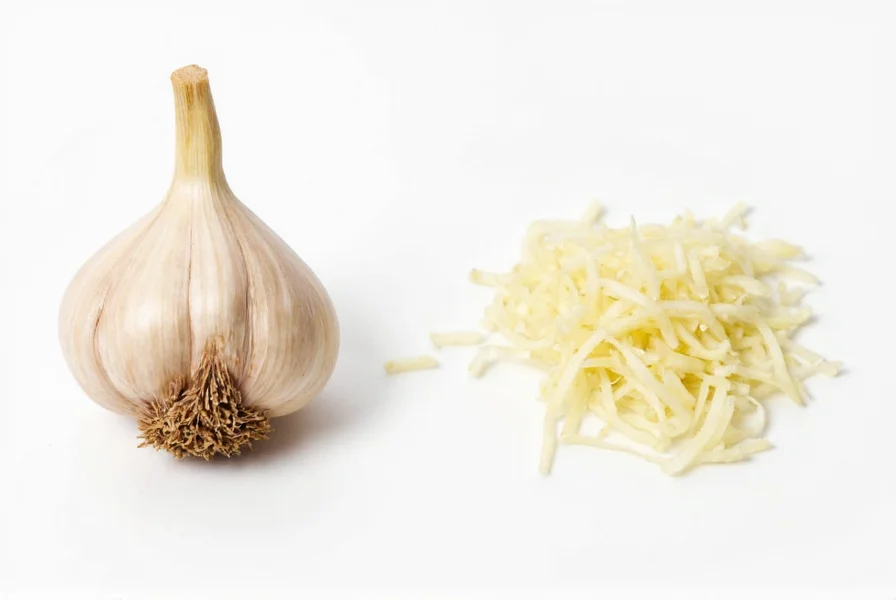Understanding Garlic Measurements: From Whole Cloves to Minced
When following recipes, you've likely encountered the frustrating discrepancy between "1 garlic clove" and "1 teaspoon minced garlic." Understanding these conversions prevents culinary disasters and ensures your dishes achieve the perfect garlic balance. Let's explore the precise measurements and techniques that transform whole cloves into perfectly proportioned minced garlic.
Garlic Clove to Minced Conversion Chart
| Garlic Size | Whole Cloves | Minced Garlic Equivalent | Weight Equivalent |
|---|---|---|---|
| Small | 1 clove | 1 teaspoon | 3 grams |
| Medium | 1 clove | 1½ teaspoons | 5 grams |
| Large | 1 clove | 2 teaspoons | 7 grams |
| Extra Large | 1 clove | 2½ teaspoons | 9 grams |
Factors Affecting Garlic Conversion Accuracy
The precise minced garlic equivalent depends on several variables that home cooks must consider for recipe accuracy:
Clove Size Variability
Garlic bulb varieties produce cloves of dramatically different sizes. A single supermarket bulb might contain both small inner cloves (yielding just 1 teaspoon minced) and large outer cloves (producing over 2 teaspoons). When recipes specify "1 clove," they typically assume a medium-sized clove from a standard grocery store bulb.
Mincing Technique Matters
Your mincing method significantly impacts volume:
- Knife-minced: Yields 1½-2 teaspoons per medium clove with visible texture
- Microplane-grated: Produces denser 1-1¼ teaspoons due to cell structure breakdown
- Food processor: Creates 2¼+ teaspoons with more air incorporation
Visual guide showing the volume difference between whole cloves and their minced equivalents
Practical Conversion Guide for Home Cooks
When substituting between forms, follow these professional kitchen standards:
Fresh Clove to Minced Substitutions
For most savory dishes, use this reliable conversion:
- 3 medium cloves = 4½ teaspoons (1½ tablespoons) minced garlic
- 6 medium cloves = 9 teaspoons (3 tablespoons) minced garlic
- 12 medium cloves = 18 teaspoons (1/2 cup) minced garlic
Using Pre-Minced Garlic from Jars
Store-bought minced garlic requires adjustment due to preservatives and texture differences:
- Reduce jarred minced garlic by 25% compared to fresh minced equivalents
- Add 1/4 teaspoon lemon juice per tablespoon to brighten flavor
- Always drain excess liquid before measuring
Proper Garlic Mincing Technique
Achieving consistent minced garlic requires proper technique:
- Peel the clove by smashing with your knife's flat side
- Remove the central sprout if present (bitter flavor)
- Stack slices tightly before rocking your knife
- Continue mincing until uniform with no large chunks
- Check consistency by pinching between fingers - should hold shape briefly
Common Measurement Mistakes to Avoid
Even experienced cooks make these critical garlic conversion errors:
- Assuming all cloves are equal: Outer bulb cloves are typically 30-50% larger than inner cloves
- Ignoring moisture content: Freshly minced garlic contains water that affects volume measurements
- Using volume measurements for roasted garlic: Roasted cloves yield 30% less volume due to moisture loss
- Substituting garlic powder incorrectly: 1/8 teaspoon garlic powder = 1 teaspoon fresh minced garlic
Storage Tips for Minced Garlic
Preserve flavor and prevent waste with these storage methods:
- Refrigerate in airtight container for up to 5 days (add oil to prevent browning)
- Freeze in ice cube trays with olive oil (1 cube = 1 teaspoon minced garlic)
- Store in vinegar for up to 3 weeks (changes flavor profile slightly)
- Never store minced garlic in oil at room temperature (botulism risk)
When Precision Matters Most
Certain dishes require exact garlic measurements:
- Vinaigrettes and emulsions: Excess garlic can break emulsions
- Pasta sauces: Overpowering garlic masks tomato flavors
- Marinades: Too much garlic creates bitter notes when cooked
- Baking: Garlic bread requires precise ratios for balanced flavor











 浙公网安备
33010002000092号
浙公网安备
33010002000092号 浙B2-20120091-4
浙B2-20120091-4